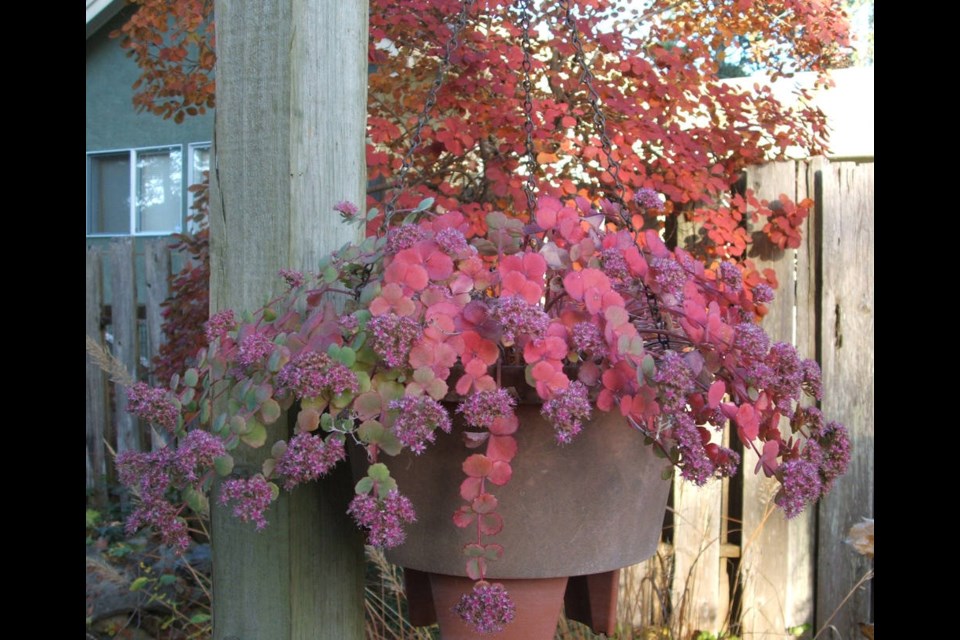Many home landscapes include plants, mainly trees and shrubs, that resident gardeners treasure for their display of vivid colour in the fall. These plants declare the winding down of an active growing season. They are a last, loud proclamation of vibrant life, a prelude to a time of quiet and repose.
We all have our favourites. I relish the bright red leaves setting off long-fingered white flowers on a tall sorrel (Oxydendrum, sourwood) tree, the peach and gold of a flowering plum, the sheet of bright yellow spread beneath an Enkianthus shrub.
Depending on the summer and early autumn weather, foliage-colour changes that occur in mid and late fall can display intriguing variations from year to year. I’ve been noticing more rosy-copper leaf colouring and less purple than usual in the smoke tree, but the plant that has attracted my attention most acutely is a long-stemmed, spreading sedum in a basket hanging from an arbour in front of the smoke tree.
The sedum has occupied the same basket for years. It’s a low-care plant that is easy to take for granted. A quick cleanup in spring, a little fresh planting mix, the occasional watering in summer — that’s about all the attention it requires. I can’t say why I’ve not noticed the plant’s vivid fall colouring before.
Sedum sieboldii, when looked at closely, is exquisite. The spreading stems bear blue-green leaves with lightly scalloped, deep-pink margins. The leaves attach to the stem in groups of three. Pink flower clusters appear in autumn. The fall colouring precedes the shedding of top growth and winter dormancy before fresh stems and leaves emerge in spring.
The plant’s colour changes have been fascinating to monitor. Over four cold days, early in the month, the pretty little leaves changed from dark apricot-pink to a lively peach-hued red.
Its spreading habit makes Sedum sieboldii ideal for growing in containers, especially hanging baskets, sited where the charming details of the plant can be fully appreciated, close up.
Food play. How many of us, as children, fiddling with food on a plate at a meal, remember being told, “Don’t play with your food!” That memory surfaced often over recent months as I “played” with different ways of preparing the garden’s vegetables and fruits. That is surely one of the great pleasures in food gardening — finding new ways to use the food we’ve grown.
My attraction to ginger has coloured much of my experimentation as I’ve cooked with this year’s blueberries, prune plums and apples, making jams, sauces, pies, crumbles and cobblers.
I sliced the last few Discovery apples last month into a small amount of fresh lemon juice and water in a big wok. As they cooked, I used kitchen scissors to snip small bits of candied ginger into the apples. No more sugar was needed. The ginger sweetened and flavoured the apples to perfection.
When the apples had cooled a little, I spooned them into a partly baked pie shell (around 12 minutes at 350 F.) and, to make an apple custard pie, I poured over the apples a blend of three tablespoons flour, one-half teaspoon salt, and one-third each sugar and light cream.
The pie, topped with slivered almonds dusted with cinnamon and sugar, is covered loosely with foil and baked one hour at 375 F, then baked uncovered for 15 to 20 minutes more.
That left a small amount of the cooked apples, which I processed in a blender. Because Discovery apple flesh is tinged red, the resulting applesauce is a beautiful deep pink. The texture is silky-smooth, the flavour deliciously ginger-infused.
Mixing It Up 2021. “Roots, Shoots and Leaves” is the theme of the virtual Mixing It Up in the Urban Garden Conference on Saturday, Jan. 30, 9 a.m. to 4 p.m. The day will include five speakers, connections with vendors, gardeners’ chat rooms, Victoria Master Gardeners’ silent auction and more. The speakers and their topics:
• Richie Steffen: Plant Picks For Our Changing Climate.
• Dr. Linda Gilkeson: Addressing Climate Change from the Roots Up.
• Ron Carter: Trees Now and Forever.
• Bianca Bodley: No Yard? No Problem! — Gardening in Small Spaces.
• Dr. Drew Zwart: If Leaves Could Talk: Want to know what’s best for your plants? Listen to their Leaves.
Registration is open now at . Cost is $55. Zoom coaching will be available before the conference. Full details on the talks can be found on the site.



